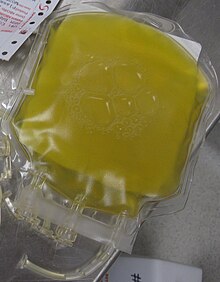
Back بلازما متجمدة جديدة Arabic Gefrorenes Frischplasma German Plasma fresco congelado Spanish پلاسمای منجمد تازه Persian Plasma frais congelé French עירוי פלזמה HE Թարմ սառեցված պլազմա Armenian Plasma fresco congelato Italian ഫ്രഷ് ഫ്രോസൺ പ്ലാസ്മ Malayalam Vers bevroren plasma Dutch
 A bag containing one unit of fresh frozen plasma | |
| Clinical data | |
|---|---|
| Other names | Plasma frozen within 24 hours after phlebotomy (FP24)[1] |
| AHFS/Drugs.com | Micromedex Detailed Consumer Information |
| ATC code | |
| Identifiers | |
| ChemSpider |
|
Fresh frozen plasma (FFP) is a blood product made from the liquid portion of whole blood.[3] It is used to treat conditions in which there are low blood clotting factors (INR > 1.5) or low levels of other blood proteins.[3][1] It may also be used as the replacement fluid in plasma exchange.[2][4] Using ABO compatible plasma, while not required, may be recommended.[5][6] Use as a volume expander is not recommended.[3] It is administered by slow injection into a vein.[2]
Side effects include nausea and itchiness.[3] Rarely there may be allergic reactions, blood clots, or infections.[1][3] It is unclear if use during pregnancy or breastfeeding is safe for the baby.[2] Greater care should be taken in people with protein S deficiency, IgA deficiency, or heart failure.[2] Fresh frozen plasma is made up of a complex mixture of water, proteins, carbohydrates, fats, and vitamins.[1] When frozen it lasts about a year.[1]
Plasma first came into medical use during the Second World War.[1] It is on the World Health Organization's List of Essential Medicines.[7] In the United Kingdom it costs about £30 per unit.[8] A number of other versions also exist including plasma frozen within 24 hours after phlebotomy, cryoprecipitate reduced plasma, thawed plasma, and solvent detergent plasma.[1]
- ^ a b c d e f g Ko H, Lekowski RW (2013). "Blood products". In Shaz BH, Hillyer CD, Roshal M, Abrams CS (eds.). Transfusion Medicine and Hemostasis: Clinical and Laboratory Aspects. Newnes. pp. 209–212. ISBN 9780123977885. Archived from the original on 2017-09-23.
- ^ a b c d e "Plasma Intravenous Advanced Patient Information - Drugs.com". www.drugs.com. Archived from the original on 11 January 2017. Retrieved 10 January 2017.
- ^ a b c d e British national formulary : BNF 69 (69 ed.). British Medical Association. 2015. p. 172. ISBN 9780857111562.
- ^ Schwartz J, Padmanabhan A, Aqui N, Balogun RA, Connelly-Smith L, Delaney M, et al. (June 2016). "Guidelines on the Use of Therapeutic Apheresis in Clinical Practice-Evidence-Based Approach from the Writing Committee of the American Society for Apheresis: The Seventh Special Issue". Journal of Clinical Apheresis. 31 (3): 149–162. doi:10.1002/jca.21470. PMID 27322218. S2CID 866923.
- ^ Joy MA, Eshraghi Y, Novikov M, Bauer A (2015). "Transfusion Medicine". In Sikka PK, Beaman ST, Street JA (eds.). Basic Clinical Anesthesia. Springer. p. 102. ISBN 9781493917372.
- ^ Aglio LS, Lekowski RW, Urman RD (2015). Essential Clinical Anesthesia Review: Keywords, Questions and Answers for the Boards. Cambridge University Press. p. 218. ISBN 9781107681309.
- ^ World Health Organization (2019). World Health Organization model list of essential medicines: 21st list 2019. Geneva: World Health Organization. hdl:10665/325771. WHO/MVP/EMP/IAU/2019.06. License: CC BY-NC-SA 3.0 IGO.
- ^ Yentis SM, Hirsch NP, Ip J (2013). Anaesthesia and Intensive Care A-Z: An Encyclopedia of Principles and Practice. Elsevier Health Sciences. p. 147. ISBN 9780702053757. Archived from the original on 2017-09-23.
© MMXXIII Rich X Search. We shall prevail. All rights reserved. Rich X Search